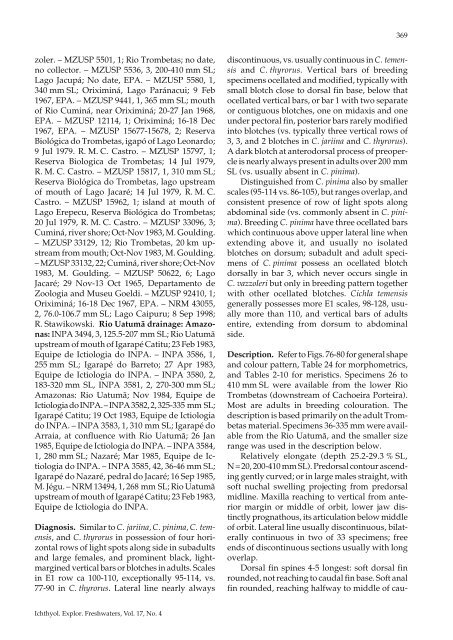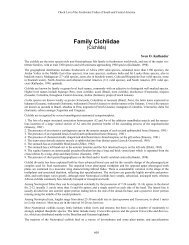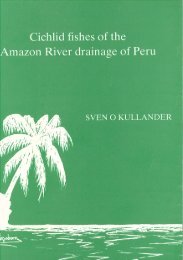Open Access PDF - Sven Kullander
Open Access PDF - Sven Kullander
Open Access PDF - Sven Kullander
You also want an ePaper? Increase the reach of your titles
YUMPU automatically turns print PDFs into web optimized ePapers that Google loves.
zoler. – MZUSP 5501, 1; Rio Trombe tas; no date,<br />
no collector. – MZUSP 5536, 3, 200-410 mm SL;<br />
Lago Jacupá; No date, EPA. – MZUSP 5580, 1,<br />
340 mm SL; Oriximiná, Lago Paránacui; 9 Feb<br />
1967, EPA. – MZUSP 9441, 1, 365 mm SL; mouth<br />
of Rio Cuminá, near Oriximiná; 20-27 Jan 1968,<br />
EPA. – MZUSP 12114, 1; Oriximiná; 16-18 Dec<br />
1967, EPA. – MZUSP 15677-15678, 2; Reserva<br />
Biológica do Trombetas, igapó of Lago Leonardo;<br />
9 Jul 1979. R. M. C. Castro. – MZUSP 15797, 1;<br />
Reserva Biologica de Trombetas; 14 Jul 1979,<br />
R. M. C. Castro. – MZUSP 15817, 1, 310 mm SL;<br />
Reserva Biológica do Trombetas, lago upstream<br />
of mouth of Lago Jacaré; 14 Jul 1979, R. M. C.<br />
Castro. – MZUSP 15962, 1; island at mouth of<br />
Lago Erepecu, Reserva Biológica do Trombetas;<br />
20 Jul 1979, R. M. C. Castro. – MZUSP 33096, 3;<br />
Cuminá, river shore; Oct-Nov 1983, M. Goulding.<br />
– MZUSP 33129, 12; Rio Trombetas, 20 km upstream<br />
from mouth; Oct-Nov 1983, M. Goulding.<br />
– MZUSP 33132, 22; Cuminá, river shore; Oct-Nov<br />
1983, M. Goulding. – MZUSP 50622, 6; Lago<br />
Jacaré; 29 Nov-13 Oct 1965, Departamento de<br />
Zoologia and Museu Goeldi. – MZUSP 92410, 1;<br />
Oriximiná; 16-18 Dec 1967, EPA. – NRM 43055,<br />
2, 76.0-106.7 mm SL; Lago Caipuru; 8 Sep 1998;<br />
R. Stawi kowski. Rio Uatumã drainage: Amazonas:<br />
INPA 3494, 3, 125.5-207 mm SL; Rio Uatumã<br />
upstream of mouth of Igarapé Catitu; 23 Feb 1983,<br />
Equipe de Ictiologia do INPA. – INPA 3586, 1,<br />
255 mm SL; Igarapé do Barreto; 27 Apr 1983,<br />
Equipe de Ictiologia do INPA. – INPA 3580, 2,<br />
183-320 mm SL, INPA 3581, 2, 270-300 mm SL;<br />
Amazonas: Rio Uatumã; Nov 1984, Equipe de<br />
Ictiologia do INPA. – INPA 3582, 2, 325-335 mm SL;<br />
Igarapé Catitu; 19 Oct 1983, Equipe de Ictiologia<br />
do INPA. – INPA 3583, 1, 310 mm SL; Igarapé do<br />
Arraia, at con fluence with Rio Uatumã; 26 Jan<br />
1985, Equipe de Ictiologia do INPA. – INPA 3584,<br />
1, 280 mm SL; Nazaré; Mar 1985, Equipe de Ictiologia<br />
do INPA. – INPA 3585, 42, 36-46 mm SL;<br />
Igarapé do Nazaré, pedral do Jacaré; 16 Sep 1985,<br />
M. Jégu. – NRM 13494, 1, 268 mm SL; Rio Uatumã<br />
upstream of mouth of Igarapé Catitu; 23 Feb 1983,<br />
Equipe de Ictiologia do INPA.<br />
Diagnosis. Similar to C. jariina, C. pinima, C. temensis,<br />
and C. thyrorus in possession of four horizontal<br />
rows of light spots along side in subadults<br />
and large females, and prominent black, lightmargined<br />
vertical bars or blotches in adults. Scales<br />
in E1 row ca 100-110, exceptionally 95-114, vs.<br />
77-90 in C. thyrorus. Lateral line nearly always<br />
Ichthyol. Explor. Freshwaters, Vol. 17, No. 4<br />
369<br />
discontinuous, vs. usually continuous in C. temensis<br />
and C. thyrorus. Vertical bars of breeding<br />
specimens ocellated and modified, typically with<br />
small blotch close to dorsal fin base, below that<br />
ocellated vertical bars, or bar 1 with two separate<br />
or contiguous blotches, one on midaxis and one<br />
under pectoral fin, posterior bars rarely modified<br />
into blotches (vs. typically three vertical rows of<br />
3, 3, and 2 blotches in C. jariina and C. thyrorus).<br />
A dark blotch at anterodorsal process of preopercle<br />
is nearly always present in adults over 200 mm<br />
SL (vs. usually absent in C. pinima).<br />
Distinguished from C. pinima also by smaller<br />
scales (95-114 vs. 86-105), but ranges overlap, and<br />
consistent presence of row of light spots along<br />
abdominal side (vs. commonly absent in C. pinima).<br />
Breeding C. pinima have three ocellated bars<br />
which continuous above upper lateral line when<br />
extending above it, and usually no isolated<br />
blotches on dorsum; subadult and adult specimens<br />
of C. pinima possess an ocellated blotch<br />
dorsally in bar 3, which never occurs single in<br />
C. vazzoleri but only in breeding pattern together<br />
with other ocellated blotches. Cichla temensis<br />
generally possesses more E1 scales, 98-128, usually<br />
more than 110, and vertical bars of adults<br />
entire, extending from dorsum to abdominal<br />
side.<br />
Description. Refer to Figs. 76-80 for general shape<br />
and colour pattern, Table 24 for morphometrics,<br />
and Tables 2-10 for meristics. Specimens 26 to<br />
410 mm SL were available from the lower Rio<br />
Trombetas (downstream of Cachoeira Porteira).<br />
Most are adults in breeding colouration. The<br />
description is based primarily on the adult Trombetas<br />
material. Specimens 36-335 mm were available<br />
from the Rio Uatumã, and the smaller size<br />
range was used in the description below.<br />
Relatively elongate (depth 25.2-29.3 % SL,<br />
N = 20, 200-410 mm SL). Predorsal contour ascending<br />
gently curved; or in large males straight, with<br />
soft nuchal swelling projecting from predorsal<br />
midline. Maxilla reaching to vertical from anterior<br />
margin or middle of orbit, lower jaw distinctly<br />
prognathous, its articulation below middle<br />
of orbit. Lateral line usually discontinuous, bilaterally<br />
continuous in two of 33 specimens; free<br />
ends of discontinuous sections usually with long<br />
overlap.<br />
Dorsal fin spines 4-5 longest: soft dorsal fin<br />
rounded, not reaching to caudal fin base. Soft anal<br />
fin rounded, reaching halfway to middle of cau-




